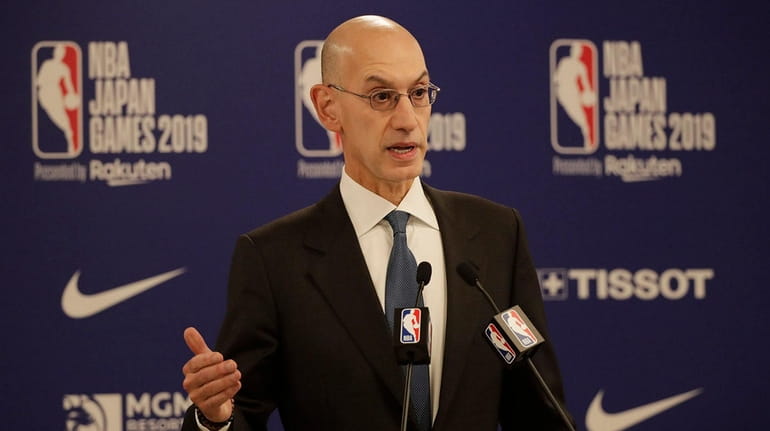An NBA season during the COVID-19 pandemic needs a big dose of luck

NBA commissioner Adam Silver speaks at a news conference on Oct. 8, 2019, in Japan. The league is out of the bubble as the new season begins Dec. 22. Credit: AP / Jae C. Hong
The NBA released the schedule for the first half of the season Friday afternoon, heralding its arrival with the usual televised breakdown of the big matchups on opening night and the Christmas Day events.
And to this, all we can say is good luck.
Really, everyone hopes the NBA somehow can pull off this season after a successful run through the Orlando bubble. Last season's restart stood out as an example of how to manage a way through the pandemic, utilizing science and medicine.
But it’s also hard to ignore that every lesson learned from that seems to have been pushed aside in an effort to get teams back into their arenas and get as close to a complete NBA season on television as possible.
The bubble is gone. Teams are back to their home arenas and practice facilities (except for the Toronto Raptors, who have relocated to Tampa at least for the start of the season, thanks to Canada’s unwillingness to bend the restrictions to help them).
The notion of a division-weighted schedule was abandoned. The 72-game schedule — only the first half was announced, which probably should serve as a caution flag for the league’s belief that this will work — includes all of the normal stops, with every team visiting every city.
"This season more than ever, COVID and injuries are going to have more effect on playoff seedings or teams making or not making playoffs than ever before," Paul Pierce said on ESPN’s The Jump. "I can see that coming. You’re going to have guys miss three or four games because of COVID and maybe [they’re] one game behind a playoff spot, in position where a guy they really need in their rotation is not going to be there. It’s fair game, fair game across the league."
The promise of a 25% reduction in travel might work on a calculator, but you’d have a hard time explaining that math to some teams right now.
The Golden State Warriors will start the season by traveling cross-country so TNT can get a matchup with the Brooklyn Nets and Kevin Durant. They then will fly to Milwaukee for a Christmas Day game before continuing on to Chicago and Detroit, at least nine nights on the road.
The Knicks will have a stretch in which they are on the road for 20 days out of 30 from Dec. 28-Jan. 26.
"I think the league has done a great job of putting the proper protocols in place and making sure we’re as safe as possible," Knicks forward Julius Randle said. "I think it’ll be weird for my son, and my wife as well, but more for my son, seeing his dad home for the past nine months or so, so it’ll be an adjustment for him. But as far as the health, the precautions and stuff, everybody has done a great job and everybody around the NBA has done a great job of putting the players first and making sure we stay healthy."
The league certainly is going to try. The 139-page Health and Safety Protocol guide that the league provided to teams covers every possible scenario, explaining not only testing and quarantine rules but factors such as media availability, meal planning, car services and sponsorship commitments.
Nearly 10% of the players arrived at the team facilities from their homes and tested positive. That's alarming, given that they knew the testing was coming and that figure includes no interaction among the players. Will some of those same behaviors that caused them to test positive continue when a team is on the road for a trip stretching more than a week, in cities where the CDC rules are flouted and the tightly guarded bubble doesn’t exist?
The number of cases, hospitalizations and deaths are spiking now, far exceeding what was in place when the league shut down March 11 early in the pandemic. While everyone hopes for the best, some understand the reality better than others. It's not just about keeping the players safe; the older coaches, the officials and executives, the arena employees and the fans have to be considered. And maybe just as much, the families of all of those people.
The Timberwolves' Karl-Anthony Towns spoke on a Zoom call Friday and recounted the tragedy he and his family have faced since the league shut down in March. He lost his mother to the virus, his father was ill with it before recovering and he lost other family members.
"I've been through a lot, obviously starting out with my mom," Towns said. "Last night, I got a call that I lost my uncle. I feel like I've been hardened a little bit by life and humbled.
"I've seen a lot of coffins in the last seven months. I have a lot of people who have — in my family and my mom's family — gotten COVID. I'm the one looking for answers still, trying to find how to keep them healthy. It's just a lot of responsibility on me to keep my family well informed and to make all the moves necessary to keep them alive."
While some insist the game must go on and that business is business, this time around, it seems as if it's happening with fingers crossed tightly.

